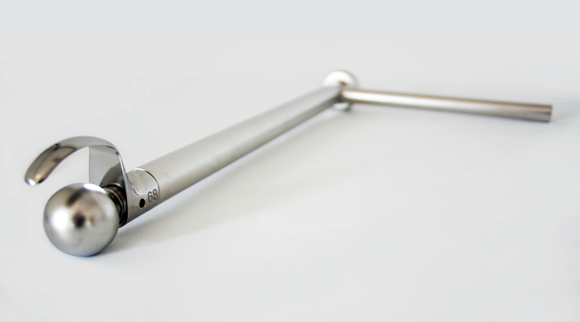Additively manufactured cutting blades enable improved medical implant extraction
September 18, 2018

The endoCupcut developed by Endocon allows for the more accurate extraction of medical implants (Courtesy GE Additive)
Medical devices company Endocon GmbH, Heidelberg, Germany, has developed a new device which uses metal additively manufactured cutting blades, produced on a GE Concept Laser system, to enable more accurate extraction of used acetabular (hip) cups. The new design reportedly improves product reliability, cost savings and the patient and clinician experience.
The removal of a hip cups from patients following implantation, such as in the event of loosening, abrasion or infection, presents a complex task for surgeons, for whom very few devices are available for the job. The removal process often involves the use of a chisel, which risks damaging bone and tissue and can leave the bone with an uneven surface, making the insertion of a replacement implant more difficult.
Endocon has addressed the need for a better removal technique with the creation of an acetabular cup cutter, the endoCupcut, which was developed using GE Additive’s Concept Laser technology, allows for more precise cutting along the edge of the acetabular cup and is said to offer surgeons the opportunity to loosen and extract cementless hip cups quickly, without adding additional damage to the surrounding bone.
The device is reusable, and allows surgeons to implant the same size hip cup that was implanted before. It offers variability in one instrument and can be combined with up to fifteen additively manufactured stainless steel blades, in various shapes and sizes, ranging from 44–72 mm.
Traditionally, cutting blades have been manufactured by casting. However, relying on a such a time-consuming and laborious process, especially for multiple sizes and shapes, meant that the production time for a single batch of blades could be as long as three and a half months. Cast blades also often present other problems, such as corrosion, and difficulty in achieving repeatable quality and consistency of hardness without reducing tensile strength, resulting in a rejection rate of around 30%.
The blades used in the endoCupcut are manufactured in 17-4 PH stainless steel on a Concept Laser Mlab Cusing 100R machine, which uses Laser Powder Bed Fusion. Including post-processing, the lead time for new blades is now just three weeks.
Klaus Notarbartolo, General Manager at Endocon, added, “We’ve also been able to reduce the cost per blade by around forty to forty-five per cent. That means cost savings for us and in turn for our customers. When you combine that with a reduction in product development time, higher efficiency and lower rejection rates, then the business case for additive really becomes attractive.”
Local service bureau Weber-KP, a metal AM specialist, manages all stages of the process for Endocon, handling data preparation, build orientation, and the build itself through to high-quality surface finishing, hardening and bead blasting. Depending on the size and orientation in the build envelope between two and six blades can be built on a 90 x 90 mm build platform.
According to Endocon, the blades now show excellent corrosion resistance and, instead of cracking after 600 N, the show a plastic deformation after applying 1.8 kN. Previous issues with achieving a consistent hardness level have also been resolved using AM, showing an improvement to 42+-2 HRC, compared to 32 HRC using casting.
Harder, stronger, more reliable blades not only perform better in the operating room, Endocon stated, they also address patient safety concerns by reducing the risk of breakage and splinters embedding into the tissue. From the surgeons’ and the hospitals’ perspective, the risk of failure is taken out of the surgery and fatigue is indicated by plastic deformation. This saves the hospital both time and money.
Stephan Zeidler, Business Development Manager Medical at GE Additive, commented, “Endocon’s ability to solve multiple challenges using additive is an impressive example of how it can have a positive impact for smaller companies targeting the orthopaedic industry.”
“What started with the need for a reduced time-to-market in terms of product development and flexible production of various shapes and sizes has resulted in a smart, innovative medical product that enhances patient outcomes,” he continued. “Moving the entire production process from casting to AM was a logical step and that shift continues to provide inspiration for future projects.”
Endocon reported that the device has been positively received and is already being used by a number of medical professionals across Germany. This fast and safe procedure has significantly reduced the surgery time from around half an hour to just three minutes. Compared to the previous chisel method, the endoCupcut’s precise cutting method preserves the maximum amount of bone substance and supports an accelerated healing process for the patient.
















